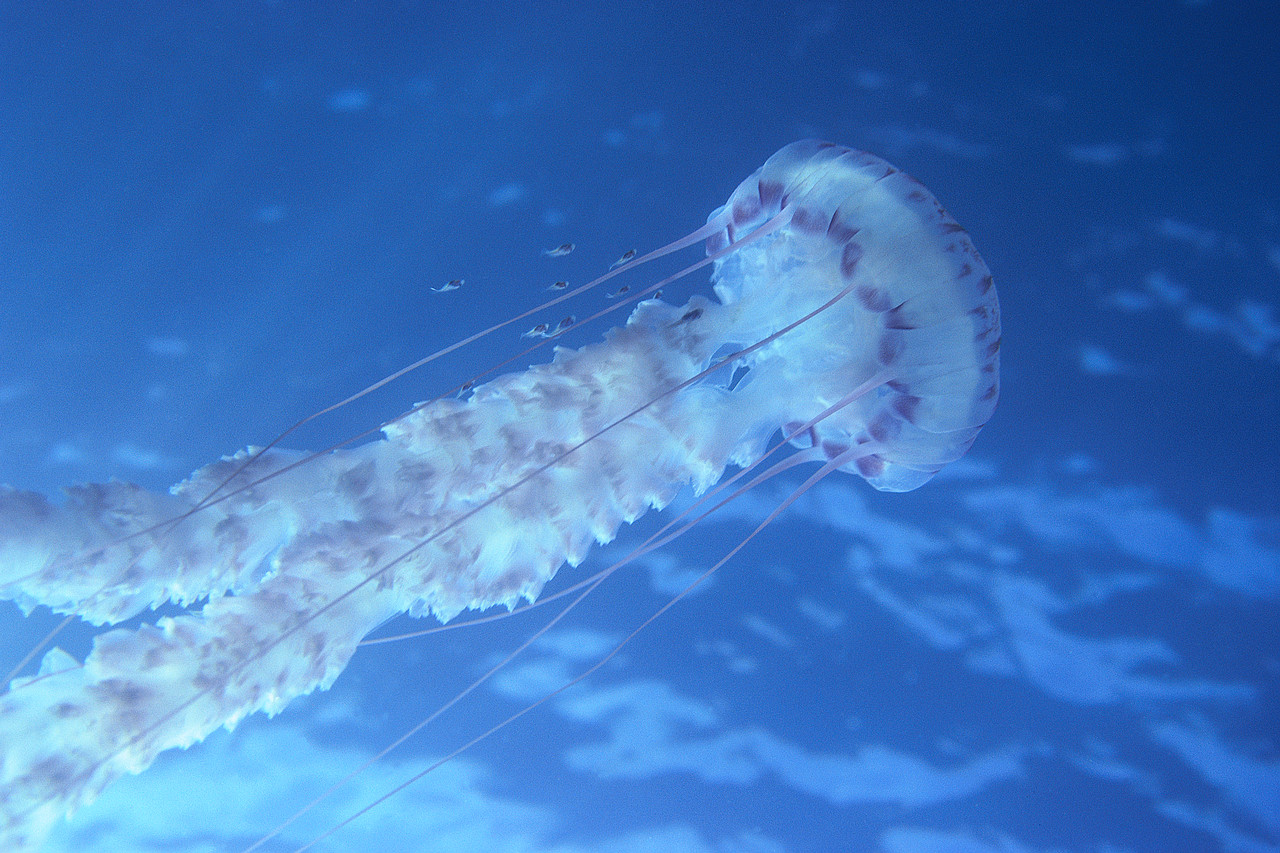Invertebrate
Zoology Cnidaria
Members of the phylum Cnidaria are incredibly diverse, from the Portuguese man-of-war with its balloon-like float to the giant medusae and corals. The name Cnidaria comes from the Greek word "cnidos," which means stinging nettle. Casually touching many cnidarians will make it clear how they got their name when their stinging cells (cnidocytes) discharge nematocysts equipped with barbs and poison. The cnidarians are the least complex animals with true tissues, but no specialized organs. The over 9,000 species are nearly all marine, distributed from the surface of the ocean to the bottom and from the tropics to the poles; there are only a few freshwater species.
 |
Phylum Cnidaria
1.
Characteristics: Diploblastic, sessile or
pelagic, usually carnivores, tissue-level organization
2.
Radial or biradial symmetry
4.
Gelatinous mesoglea between the epidermal
and gastrodermal tissue layers
5.
Gastrovascular cavity
7.
Nervous system in the form of a nerve
net 8. Specialized cells, called cnidocysts (nematocysts), used in defense, prey capture and attachment
|
Cnidarians are radially symmetrical. Radially symmetrical animals have no anterior
or posterior ends. Thus, terms of direction are based on the
position of the mouth opening. The end of the animal that contains the mouth
is the oral end, and the opposite end is the aboral end. Radial symmetry is advantageous
for sedentary animals because sensory receptors are evenly distributed around
the body. These organisms can respond
to stimuli from all directions.
Cnidarians are diploblastic (two tissue layers). The epidermis is derived embryologically from ectoderm, and the gastrodermis is derived from embryonic endoderm. Sandwiched between these layers is mesoglea, a gelatinous, noncellular layer (it may contain living cells derived from ectoderm). The mesoglea can be thin as in Hydra or so thick it makes up the bulk of the animal (jellyfish).
All animals must have a skeleton. Unlike sponges with their spicules and/or spongin, cnidarians have a fluid skeleton, known as a hydrostatic skeleton. In cnidarians, the water-filled gastrovascular cavity acts as a hydrostatic skeleton.
Most cnidarians are carnivores with cnidocytes and tentacles active in prey capture. Food captured by the tentacles surrounding the mouth is brought into the gastrovascular cavity for digestion (extracellular digestion). Extracellular digestion allows cnidarians to digest larger prey (usually small crustaceans) than protists and sponges can. Once the food particles are small enough, cnidarian digestion occurs intracellularly within the gastrodermal cells lining the gastrovascular cavity (by phagocytosis).
Cnidarian have a rudimentary nervous system known as a nerve net. This allows the animal to respond to prey, chemicals, vibrations, and temperature in its environment.
Much like choanocytes are the defining feature of sponges, stinging cells or cnidocytes define cnidarians. Cnidocytes contain a harpoonlike device, the nematocyst (the actual stinging part). When the small cnidocil (trigger) is mechanically or chemically stimulated, their nematocysts explode out of the cell, release a thread-like filament, and inject toxin into their prey.
Most cnidarians are dioecious. Sperm and eggs may be released into the gastrovascular cavity or to the outside. Sometimes eggs are retained in the parent until after fertilization. Some cnidarians also reproduce asexually by budding.
There are four major classes of cnidarians:
Hydrozoa: The hydrozoans are the most diverse group of cnidarians. Examples include Obelia, siphonophores, hydroids, fire corals, Physalia (the Portuguese man-of-war). They live attached to the bottom with their tentacles and mouth pointed up; most hydrozoans alternate between body forms with asexual reproduction in polyp form and sexual reproduction in medusa form. Hydra is an unusual hydrozoan because it occurs only as a polyp.
Anthozoa (flower animals): The anthozoans are some of the most familiar and "showy" cndarians. They include true corals, sea anemones, and sea pens; they are bottom-dwelling animals in the polyp stage, existing as either solitary individuals or as true colonies; one feature all anthozoans share is the absence of a medusa stage. The anthozoa are entirely marine.
Cubozoa: The box jelly has a squarish bell with trailing tentacles. The tentacles have millions of stinging cells, each with a nematocyst. Box jellies have potent toxins (some experts consider it the most venomous marine animal in existence). Chironex (the Indo-Paciic box jelly) typically spends the daylight hours at considerable depths, traveling upward at night to feed; however, swimmers can come in contact with them when tidal surges transport them ashore. Cubazoans can see fairly well despite not having a brain!
Scyphozoa: Scyphozoa are solitary, mostly marine animals with free-floating medusa form (polyps are small and inconspicuous). They are the true jellyfish (because of their thick layer of gelatinous mesoglea, which provides buoyancy), but because they aren't fishes, a better name is "jellies"; they drift along the water with the mouth and tentacles pointed down.
See
Return to the Invertebrate
Zoology Homepage.